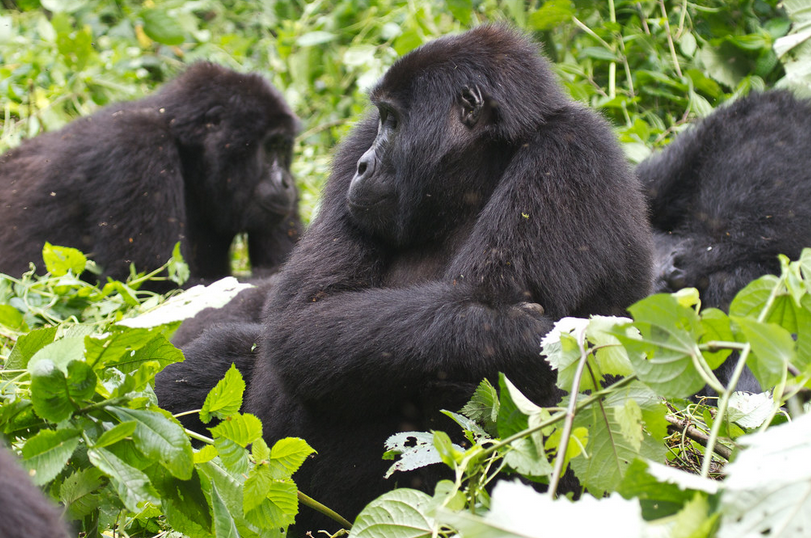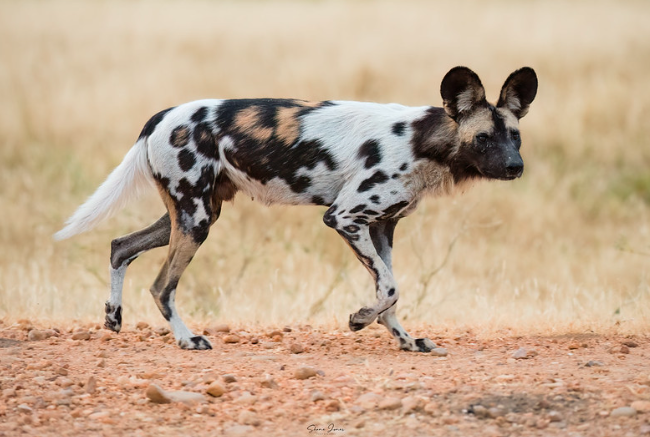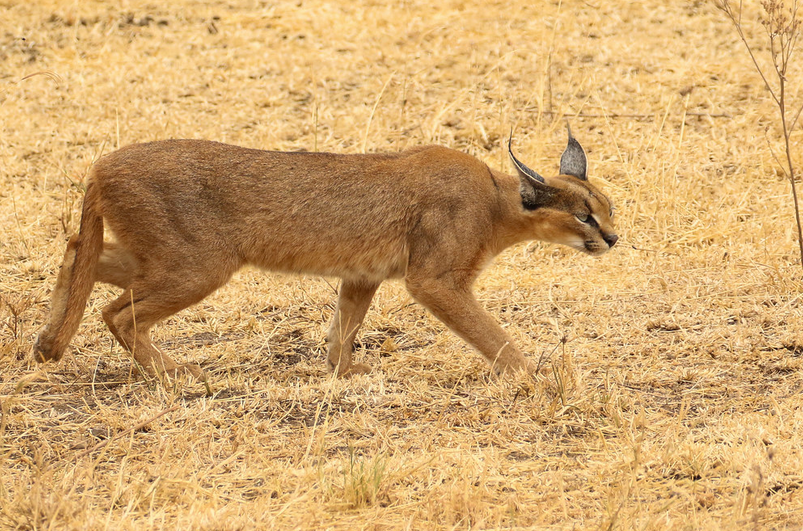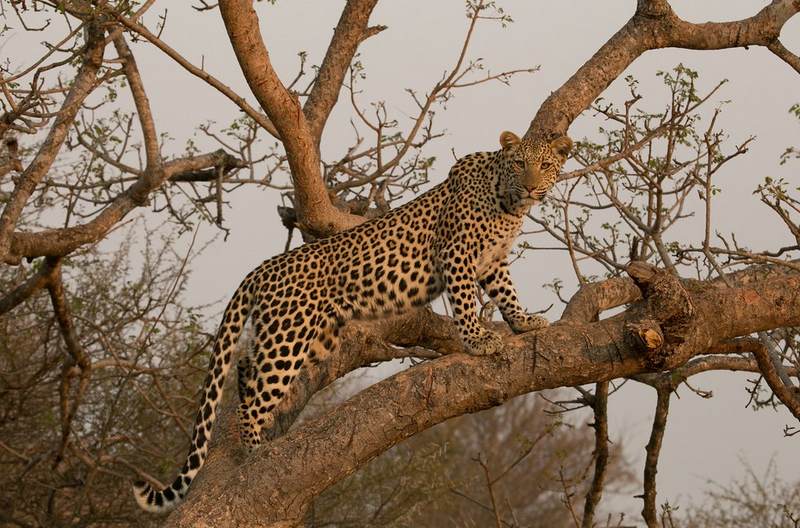Uganda birding information
Overview:
Uganda birding information: Uganda is potentially one of the best birding destinations in the world with over 50% of the total birds found on the African continent. One can record as high as 300 species of birds in Uganda especially in the Albertine Rift. Uganda has 1057 species however, new species have been added to the Uganda list and therefore the total number of species will continue to change as additional records are made through new sightings. There are over 2250 species recorded on the African continent and the total list of Uganda represents nearly half (47%) of all species recorded to the continent. This makes Uganda one of the richest countries in Africa in terms of species per unit area. The diversity is a result of the location of Uganda on the influence of major vegetation zones at the continent and good climatic conditions.
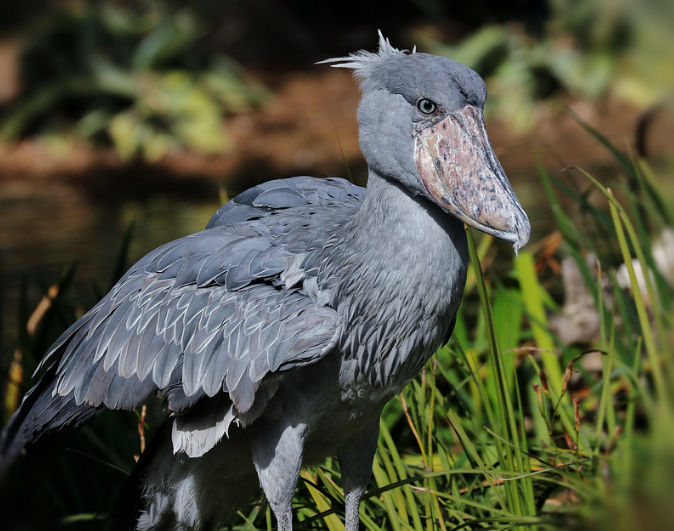
Birding Uganda
Uganda birding safaris
TOP BIRDING SITES IN UGANDA
Queen Elizabeth National Park
This is the greatest of any East African National Park, and a phenomenal number for such a small area. For the best birding in Queen Elizabeth National Park, don’t miss these birding hot spots: Kazinga Channel, Kasenyi Area, Mweya Peninsula, Maramagambo Forest, Ishasha sector, Lake Kikorongo and Katunguru Bridge.
Semliki National Park
Birding in Semliki National Park can never be exciting without sighting these beautiful birds just make sure you spend considerable amount of time birding the forest edge along the Bundibugyo road before you enter the forest because most of the forest specials can easily be seen here.
Bwindi Impenetrable Forest National Park
Bwindi Impenetrable Forest National park is home to over 347 species of birds among which are 90% of the Albertine Rift endemics. There are over 200 species of butterflies in Bwindi Forest National Park. Tourists can only visit Bwindi for mountain gorillas but the place is also a bird watchers haven.
Mgahinga Gorilla National Park
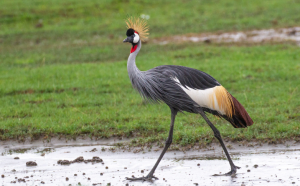
Different bird species have been recorded within the park and the park is blessed with a unique bird fauna and Notable bird species include Rwenzori Turaco, Crowned Hornbill, Black Kite, Crowned Crane, Handsome Francolin, Dusky Turtle Dove, Alpine Chat, Kivu Ground Thrush, White-tailed Blue Flycatcher, Lagden’s Bush Shrike, Scarlet-tufted Malachite Sunbird, Montane Double-collared Sunbird.
Mabamba Wetland Swamp
Mabamba swamp has grown popular as one of the best birding sites in Uganda. It should be noted that a part from Murchison falls National Park, this bird watching site is the only place and site so far rated as the best in the whole world where the endangered and shy shoe-bill stork can be seen any time of the day, anytime of the year.
Lutembe Bay
Located in Entebbe, Lutembe area is among the wetlands, which have been gazette and is a well-known for bird sanctuary. Lutembe is blessed with both water and savannah birds plus a boat ride towards the Rose bird flower gardens which gives us an exposure to the water birds.
Rwenzori Mountains National Park
An estimated total of 217 species have been recorded in the park. Birding opportunities are greatest in the Montane forest; Bee-eaters, Robins, Sunbirds and Barbets are some of the species found in the park. Other species to watch out for include the Rwenzori Turaco and Long-eared Owl; while higher up on the slopes, Bearded Vultures, Swifts and Black Eagles may be seen circling for prey.
Kyambura Wildlife Reserves
It is located on the North Eastern side of Queen Elizabeth National Park. Despite the fact that Kyambura gorge is specifically for primates, it is also a birder’s paradise and also has many beautiful butterflies that will excite your mood. The beautiful scenery and the tall trees of Kyambura wildlife reserve attract a lot of bird species to this area, for example falcon, fly catchers, white napped pigeons, blue-headed bee eaters then fin foot African bird among others. Bird watching within Kyambura wildlife reserve will excel your birding experience to another level.
Murchison Falls National Park
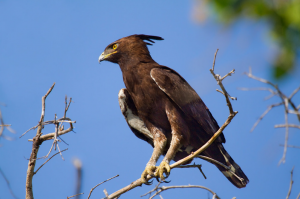 Murchison falls is among Uganda’s best birding spots with over 451 bird species which include; Albertine rift endemic birds, water birds and savannah birds. Viewing birds in the scenic landscape is among the most interesting experiences in the park. Birds in Murchison can be best spotted while on a game drive, nature walks through the savannah grasslands and on the boat cruise along the Nile and on Lake Albert Delta. Birds like the blue napped mouse birds, silver birds, weavers among others can be spotted near Paraa and Red Chilli in through the dry thorn-shrubs. Birders can watch birds all year round though best time is during the dry season in months especially from January-March, this time is a low tourist season in Uganda but birding is still plentiful. From December-February the rains begin and birding can still be done.
Murchison falls is among Uganda’s best birding spots with over 451 bird species which include; Albertine rift endemic birds, water birds and savannah birds. Viewing birds in the scenic landscape is among the most interesting experiences in the park. Birds in Murchison can be best spotted while on a game drive, nature walks through the savannah grasslands and on the boat cruise along the Nile and on Lake Albert Delta. Birds like the blue napped mouse birds, silver birds, weavers among others can be spotted near Paraa and Red Chilli in through the dry thorn-shrubs. Birders can watch birds all year round though best time is during the dry season in months especially from January-March, this time is a low tourist season in Uganda but birding is still plentiful. From December-February the rains begin and birding can still be done.
Kibale Forest National Park
With lush tropical rain forest and fascinating diversity, it is one of the most beautiful and stunning forests in Uganda. It harbors the greatest variety and concentration of primates found anywhere in East Africa. The park boasts more than 375 species of birds and these include; the African pittar, Yellow-spotted Barbet, Black-billed Turaco, White-naped Pigeon, Green-breasted Pitta, Purple-headed Starling, Red-chested Flufftail, Joyful Greenbul, Cabains Greenbul, Grey-throated Tit-flycatcher, Scarlet-tufted, Green-throated, Purple-breasted Sunbirds, White-bellied Crested Flycatchers, Masked Apalis, Tiny Sunbird, White-collared Olive-back, Black bee-eater and many others.
Entebbe Botanical Gardens
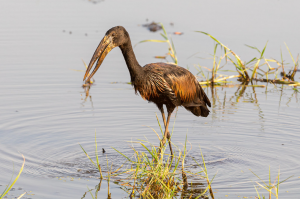 This is an ancient garden lying on the shores of Lake Victoria and the outskirts of Entebbe. It being a garden near the lake, the location makes it the number one spot for birding around Kampala and probably Entebbe as it has a mixture of forest, water and urban dweller species of birds which include: the Pink-backed Pelican, Yellow-billed Stork, Eastern Grey Plantain-eater, Yellow White-eye, Purple-banded Sunbird, African Jacana, Lesser Jacana, Yellow-billed Duck, Glossy Ibis, African Open-billed Stork, Malachite Kingfisher, Blue-Checked Bee-eater, Common Sandpiper, Wood Sandpiper, Green Sandpiper, Black Crake, Long-tailed Cormorant, Crowned Hornbill, Vieillot’ Black Weaver, Woodland Kingfisher, Pied Kingfisher, the Africa and Red-billed Fire finch, endless list.
This is an ancient garden lying on the shores of Lake Victoria and the outskirts of Entebbe. It being a garden near the lake, the location makes it the number one spot for birding around Kampala and probably Entebbe as it has a mixture of forest, water and urban dweller species of birds which include: the Pink-backed Pelican, Yellow-billed Stork, Eastern Grey Plantain-eater, Yellow White-eye, Purple-banded Sunbird, African Jacana, Lesser Jacana, Yellow-billed Duck, Glossy Ibis, African Open-billed Stork, Malachite Kingfisher, Blue-Checked Bee-eater, Common Sandpiper, Wood Sandpiper, Green Sandpiper, Black Crake, Long-tailed Cormorant, Crowned Hornbill, Vieillot’ Black Weaver, Woodland Kingfisher, Pied Kingfisher, the Africa and Red-billed Fire finch, endless list.
Best Time for Birding
Uganda birding can be done throughout the year however the best season for a birding safari is during the dry season in the months of January to March when forests are not slippery for hiking.
Some of the common bird species in Uganda
Uganda, is known as Africa’s premier birding destination with the list of birds found in the country while it is also believed that some of the birds living in the remote forests of Uganda may not even be classified as of yet and many of these birds live only in these tropical forests with rare sightings being described as “mythical”. Some of the common species sighted on the Uganda tour include;
Long-Crested eagle: Lophaetus occipital

Both male and female long-crested eagles build their nests together. While the female incubates the eggs, the male most often hunts for food and feeds the young. They are believed to have prophetic abilities in foretelling marriages; you ask where you will get the bride or groom and the direction it turns is the source of the mate. The Albertine rift woodlands and forest edges provides the best habitants where it hunts rodents and shrews which probably explains why it is always alert.
Saddle billed stork: Ephippiorhynchus senegalensis
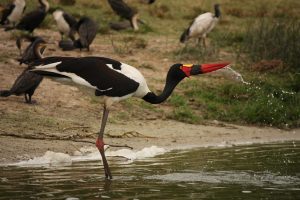
At five feet tall, the saddle-billed stork is the tallest stock in the world, and certainly one of the most strikingly beautiful. It is a wading bird with black and white plumage and a long, laterally compressed bill. The head, back, neck, wings and tail are black, while the rest of the body and the primary flight feathers are a crisp white. It is the largest and handsome of several storks usually seen in pairs on game drives in Murchison falls.
Crested crane: Balearica regulorum Gibbericeps
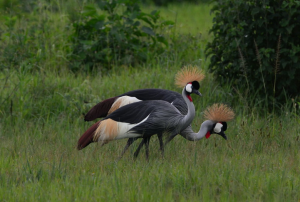
The crested crane is the National bird of the African Nation of Uganda. It appears on the Ugandan flag and can be found abundantly near the country’s many lakes and rivers that create fertile marshes rich with wildlife. Standing over 3 feet (1metre) tall with a 6-foot wingspan, the crested crane only weighs approximately 7pounds and can live up to 22 years. While many cranes make a gobbling call similar to a turkey, the crested crane honks more like a goose. They form pair bonds while they are young and will remain with the bird they bond to for the rest of their lives, breeding together each year and raising their young together.
Shoebill stork: Balaeniceps rex
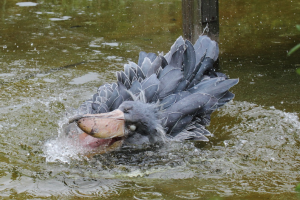 The shoebill stork is a magnificent, prehistoric-looking bird also referred to as a “ king of whale-head” and because of its enormous head size, the shoebill stork is named after its shoe-like bill which can grow up to 24cm in length and 20cm in the width. Even though they can weigh up to 6kg, they can stand quite easily on floating vegetation while hunting for fish. Featuring a prehistoric appearance, the shoebill looks like it survived the dinosaur age. Without doubt, this is one of the weirdest birds on the planet and you will most likely find them around swampy areas such; Murchison Falls National Park, Semliki wildlife reserve, Queen Elizabeth National Park and along the shores of Lake Victoria.
The shoebill stork is a magnificent, prehistoric-looking bird also referred to as a “ king of whale-head” and because of its enormous head size, the shoebill stork is named after its shoe-like bill which can grow up to 24cm in length and 20cm in the width. Even though they can weigh up to 6kg, they can stand quite easily on floating vegetation while hunting for fish. Featuring a prehistoric appearance, the shoebill looks like it survived the dinosaur age. Without doubt, this is one of the weirdest birds on the planet and you will most likely find them around swampy areas such; Murchison Falls National Park, Semliki wildlife reserve, Queen Elizabeth National Park and along the shores of Lake Victoria.
Shelley’s Crimsonwing: cryptospiza shelleyi
Your chances of spotting this colorful finch are pretty slim as it is an incredibly shy bird. It flies only short distances and takes cover (most of the time) in bamboo thickets and dense forest growth within the Albertine rift that borders the Congo, Rwanda and Uganda.
Pelicans: Pelecanus occidentalis
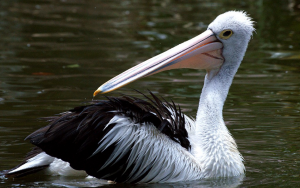
These are water birds and commonly found in Kazinga channel in Queen Elizabeth National Park. The pelican is a large bird that is most well-known for the pouch that it has in its beak which it uses to scoop fish out of the water. Pelicans eat fish, which they catch by using the extensible throat pouch as a dip-net.
The great blue turaco: Corythaeola cristata
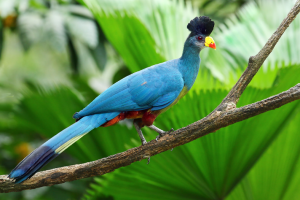 It has a turquoise-blue head with a black crest at its crown and has a blue wide long tail with long black legs and feet. The great blue turaco is a relatively shy bird that hardly perches on the group accept on rare occasions when it is going to drink or bath. Native Africans have traditionally believed that this brilliant bird brings good luck. Just like other turacos, this great bird also marks its territory all year round. They mostly live in groups of pairs, families and perhaps social groups of about seven members and feed on flowers, fruits, leaves, buds and insects. The blue turacos are not good fliers, so they only fly to lower forest levels giving birders an opportunity to view it properly while on their bird watching safaris in Uganda.
It has a turquoise-blue head with a black crest at its crown and has a blue wide long tail with long black legs and feet. The great blue turaco is a relatively shy bird that hardly perches on the group accept on rare occasions when it is going to drink or bath. Native Africans have traditionally believed that this brilliant bird brings good luck. Just like other turacos, this great bird also marks its territory all year round. They mostly live in groups of pairs, families and perhaps social groups of about seven members and feed on flowers, fruits, leaves, buds and insects. The blue turacos are not good fliers, so they only fly to lower forest levels giving birders an opportunity to view it properly while on their bird watching safaris in Uganda.
Marabou Stork: Leptoptilos crumeniferus
This is a macabre carrion-eating stork and the only bird with a Christian name “Kaloli Charles”. With cloak-like wings, skinny legs and weird-looking air sacs hanging down from the base of its neck, this tall wading bird is often regarded as one of the ugliest birds of Uganda and common in rural and urban environments especially in down town Kampala.
African Green Broadbill: Pseudocalyptomena graueri
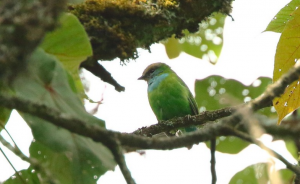
If you want to see the African green broadbill when visiting Uganda, you will need to go to Bwindi National Park because this is the only place in the country where this small, elusive bird lives. This tiny bird features a body of mostly green feathers, with light blue on the throat, breast and tail as well as a tan forehead with black streaks. While conservations are putting in forth serious efforts to protect this little rare bird, climate change and deforestation continue to threaten its numbers.
Doherty’s Bushshrike: Telophorus dohertyi
This is one of the most common birds of Uganda. If you are trekking through the tropical forests or shrub lands, you may hear the loud, territorial whistle of this bird before you even see it. The Doherty’s bushshrike even spots the vivid black, red and yellow colors of the Ugandan flag. This little solitary bird loves to feed on grasshoppers and beetles.
African paradise flycatcher: Terpsiphone viridis
This is a medium-sized passerine bird with a very long tail. The male is boldly colored in chestnut and black and the female is rather more drab. This bird feeds mainly on insects and builds a tiny cup nest in a tree where two or three eggs are laid. This species is usually found in open forests and savannah habitants.
Bar-tailed trogon: Apaloderma vittatum
Both male and females feature male bills and feet with long, wide tails. The male bar-tailed trogon features a shimmery blue-green or violet breast and iridescent blue –black head with yellow patches above and below the eyes. The female bar-tail trogon is less brilliant with a brown head and reddish-brown breast and throat.
Black bee-eater: Merops gularis
One of the most popular birds of Uganda is the black bee-eater. You will find these birds high in the forest canopies of places like Kibale National Park and Bwindi National Park. If you don’t see them at first, you can listen for their high pitched sounds of “p’sit p’sit seet”.
Black-and-white-casqued hornbill: Bycanistes subcylindricus
Also known as the grey-cheeked hornbill, it is a large-approximately 70cm (28 in) long-black and white hornbill. It has an oversized blackish bill with a large casque on top. The female is slightly smaller than the male and has a significantly smaller casque. The diet consists mainly of figs, fruits, insects and small animals found in the trees. The female usually lays up to two eggs.
Ostrich: Struthio camelus
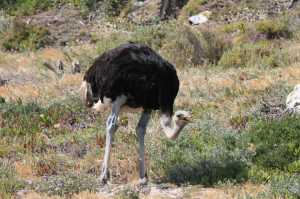 This is the largest living bird species on earth and lays the largest eggs than any other bird. It is distinctive in its appearance with a long neck and legs, and also has the fastest land speed than any other bird. This bird can run as fast as 70km/hr. ostrich produce giant eggs which are the largest of all living birds which can be 15cm long and weighing as much as two dozens of chicken eggs. Ostrich in Uganda can only be found in Kidepo Valley National Park in North Eastern part of the country and at the Uganda Wildlife Education Centre.
This is the largest living bird species on earth and lays the largest eggs than any other bird. It is distinctive in its appearance with a long neck and legs, and also has the fastest land speed than any other bird. This bird can run as fast as 70km/hr. ostrich produce giant eggs which are the largest of all living birds which can be 15cm long and weighing as much as two dozens of chicken eggs. Ostrich in Uganda can only be found in Kidepo Valley National Park in North Eastern part of the country and at the Uganda Wildlife Education Centre.
White-winged terns: Chlidonias leucopterus
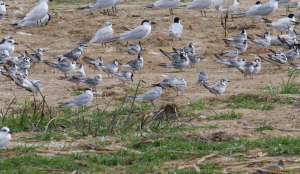 The white-winged terns are generally small bird species thriving majorly close to fresh water bodies in various parts of the world. The white-winged terns belong to the Sternidae family and are among the unique bird species explored on Uganda tours. Regarding distribution and habitat, they thrive in fresh water marshes and tend to nest on floating vegetation or on the ground near the water. They lay 2-4 eggs in their nests which they build using small reed stems along with other vegetation. The white-winged terns feed on insects and small fish.
The white-winged terns are generally small bird species thriving majorly close to fresh water bodies in various parts of the world. The white-winged terns belong to the Sternidae family and are among the unique bird species explored on Uganda tours. Regarding distribution and habitat, they thrive in fresh water marshes and tend to nest on floating vegetation or on the ground near the water. They lay 2-4 eggs in their nests which they build using small reed stems along with other vegetation. The white-winged terns feed on insects and small fish.
The goliath heron: Ardea goliath
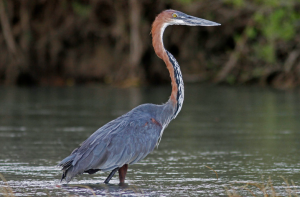 It is recorded as the world’s largest heron stretching 120-152cm in height, weighing 4-5kg and with a wing span of 185-230cm and its bill measures about 24cm from gape. It features a slow flight with a heavier presentation compared to other herons and its legs are not horizontally stretched. The eyes of goliath heron are yellow while the feet are black. The breeding of goliath heron occurs normally at the beginning of the rainy season though it can be all year round in some areas. They lay 2-5 pale blue eggs and incubation lasts 24-30 days. Chances of viewing the goliath heron are along the swamps of Lake Victoria including Mabamba, the banks of river in Murchison falls National Park.
It is recorded as the world’s largest heron stretching 120-152cm in height, weighing 4-5kg and with a wing span of 185-230cm and its bill measures about 24cm from gape. It features a slow flight with a heavier presentation compared to other herons and its legs are not horizontally stretched. The eyes of goliath heron are yellow while the feet are black. The breeding of goliath heron occurs normally at the beginning of the rainy season though it can be all year round in some areas. They lay 2-5 pale blue eggs and incubation lasts 24-30 days. Chances of viewing the goliath heron are along the swamps of Lake Victoria including Mabamba, the banks of river in Murchison falls National Park.
Malachite kingfisher: Corythonis cristatus
This is a river kingfisher which is widely distributed in Africa South of the Sahara. This species is common to reeds and aquatic vegetation near slow-moving water or ponds. The flight of the malachite kingfisher is rapid, with the short, rounded wings and usually flies low over water.
Red-headed bluebill: Spermophaga ruficapilla
This common species is found in Sub-Saharan Africa. The female bird is similar to the male but has bold white spots from the breast to vent. The red-headed bluebill is a pretty finch with a black chest spotted white in the female. The adult male bird has the whole head, breast and flanks red, with a red rump and black tail. His bill is grey with pink cutting edges. In Uganda you will easily see these birds in lodge grounds in Buhoma-Bwindi National Park.
The papyrus gonolek: Laniarius mufumbiri
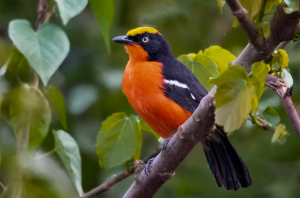 The papyrus gonolek is a medium-sized bush –shrike some 18cm (7in) long. The sexes are similar; the crown is dull yellow, the head, upper parts, wings and tail are black apart from a broad white bar on the wings. The breast and upper belly are vivid orange-crimson, and the lower belly whitish. This species is difficult to observe and has been little studied. It occurs singly or in pairs in papyrus swamps, lurking among the vegetation and only flying occasionally, usually a short distance over water to another patch of papyrus. Its presence can often be detected by its call, which consist of brief whistles and and grating tearing sounds which have been rendered as “U-tzeu-U-tzee”.
The papyrus gonolek is a medium-sized bush –shrike some 18cm (7in) long. The sexes are similar; the crown is dull yellow, the head, upper parts, wings and tail are black apart from a broad white bar on the wings. The breast and upper belly are vivid orange-crimson, and the lower belly whitish. This species is difficult to observe and has been little studied. It occurs singly or in pairs in papyrus swamps, lurking among the vegetation and only flying occasionally, usually a short distance over water to another patch of papyrus. Its presence can often be detected by its call, which consist of brief whistles and and grating tearing sounds which have been rendered as “U-tzeu-U-tzee”.
Grey heron: Ardea cinerera
The grey heron stretches up to 84-100cm in length and weighs 1-2.1kg and the life span is 15-24 years. The grey heron is marked with a white head and neck with a black stripe that extends from the eye to the black crest. The wings and body are grey while the downer parts are greyish white with some black color on the sides. The habitant of the Grey Heron comprises of shallow waters both fresh and salty, plain places but with trees for nesting, close to lakes, rivers and rice fields. The diet of Grey Heron comprises of insects, small rodents along with frogs. Birders on Ugandan tours have chances of viewing grey heron in Queen Elizabeth national Park among other protected areas. Join us on our birding safaris that have been carefully crafted or contact us for a tailor-made trip of your own.
When packing for a birding safari, proper packing is essential. Keep your equipment safe and minimize luggage difficulties. Below are some of the requirements you will need to carry before setting off for your birding tour.
Field clothing
Wearing something long protects your body from the bites and burn. Clothes should be light and with neutral safari colors whether for ladies or gents since temperatures get high and cool times of the day are generally mild. Don’t forget to carry along your birding hut and the boots.
Camera
Pack extra photo batteries, memory cards, cleaning tools or other camera accessories as well. This can be especially crucial when seeing unfamiliar birds or birding in foreign regions and you won’t want to forget your camera.
Field Guide Book
Choose guide you are comfortable using and that are a good size for guide use, without being bulky or over whelming for your luggage. You may need several different guides depending on the length of your trip and the number of destinations. You can also download the necessary guide book then use on your phone since the world is going digital, in this way you can avoid carrying bulky stuff.
Binoculars
Spotting birds on any safari needs a pair of binoculars to spot them in the air and trees. You will definitely want to capture that moment whether for a Bee-eater or a weaver bird, so don’t forget to purchase one because you will need it for the identification of the birds.
A field bag
Your field bag is essential to carry your gear, no matter where you may go birding. You will need a suitcase to carry all of your birding safari essentials but then you will also need to carry a field bag.
Request a Quote
Featured Tour Updates
Permit cost for gorilla trekking in Uganda
Permit cost for gorilla trekking in Uganda Permit cost for gorilla trekking in Uganda : Gorilla trekking is one...
The African Wild Dog
The African Wild Dog The African wild dog: (Lycaon pictus) also known as the African painted dog or Cape...
The Caracal (Felis caracal)
The Caracal (Felis caracal) The Caracal (Felis caracal): is a medium-sized wild cat that can run up to 50...
African Leopards (Panthera pardus)
African Leopards (Panthera pardus) African Leopards (Panthera pardus) : are one of the most feared but respected animals in...


